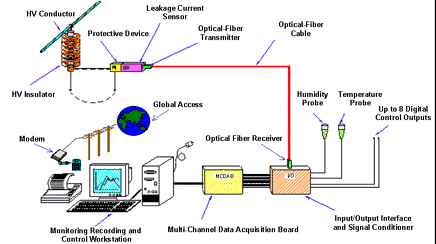Pollution Monitoring of High Voltage Insulator Surfaces
Pollution related flashovers across the HV or EHV electric power plant could be prevented if the surface pollution is monitored. The Leakage Current Monitoring System (LCMS) can be used for measuring and long-term monitoring of the leakage current on the surface of a polluted insulator. The instantaneous value of the surface leakage current and its temporal variation can be used as an indicator of the severity of insulator pollution. The LCMS system is designed to function as a monitor of conductive soluble and non-soluble pollution on the surface of an insulator. The LCMS provides on-line measurements of pollution leakage currents, logs the results, and generates appropriate alarms when necessary. A more advanced version of the system, LCMS-2, is equipped with a module which provides a periodical clean-fog whetting of the monitored insulator.
 Fig1:LCMS Block Diagram
Fig1:LCMS Block Diagram
Features of the system
- On-line LCMS system
- PC based design
- 32 bit Windows based, menu driven multitasking software support
- On-screen display of "real-time" monitoring results and Min, Max, Average values of LC over pre-selected time intervals
- Nine selectable logging rates 1, 5, 10, 30sec and 1, 5, 10, 20, 30min
- Data security using Daily, Weekly, Monthly and Yearly auto-file creation menu
- On-screen "real time" graph tracing Leakage current, Temperature and Relative Humidity changes
- Fibre optic communication link used between the HV equipment and monitoring/recording workstation.
- Compact, low cost and weather-resistant sensor design
- 2 stages of over-voltage and over-current protection
- High-level pollution Alarm dry-contact closure output
- High-level pollution Alarm monitoring and recording
- Sensor Failure Alarm on-screen monitoring
- Remote data upload via a phone line
- System Failure Alarm with dry-contact output
- Historian data log to a CSV file format suitable for Excel or any other text-based S/W applications
- 6 independent leakage current monitoring channels
- Remote data upload via the phone line
- 6 independent leakage current monitoring and recording channels
- Ambient temperature monitoring and recording
- Ambient Relative Humidity monitoring and recording
- Fast scanning rate of up to 100kHz
- Optional Spraying system for periodical artificial insulator wetting AWS
- 7 days timer to control all 6 output channels for periodic insulator spraying
- Mouse operated Human to Machine Interface HMI
Specifications
LC Sensor Sensitivity (a measuring resistor determines the sensitivity range of the LCMS)
Measuring resistor 10W, 50W, 100W, 1000W
Leakage current range 0.1-400mA, 0.02-80mA, 0.01-40mA, 0.001-4mA
Resolution 100mA, 20mA, 10mA, 1mA
Other Characteristics of LC sensor (without measuring resistor)
Continuous RMS level 4 V RMS
Input Impedance 10E+12W
Accuracy of Output +/-05% of FS reading
Transmission Frequency Range 0-10kHz
Total Error for 1kHz Sine Wave Input for 0-2 V rms. 0.3/0.3 +/-mV, +/-% of reading
for 0-4 V rms. +/-2% max of reading
Non-linearity for 0-2 V ac. 0.25 % of reading
Power Consumption 0.25 VA each
Power supply requirements 5V DC +/-12%
Built-in Overcurrent Protection 20kA
Built-in Overvoltage Protection 64V
Overall dimensions 150 x 110 x 65 mm
Weight 350g
Optical Fiber Communication Cable
Type Multimode 62.5/125
Maximum length of transmission 1000m
Connector type ST
Combined Temperature and Humidity Sensor
Temperature -10 to +60deg C +/-0.5%
Relative Humidity 35 to 95% +/-3%